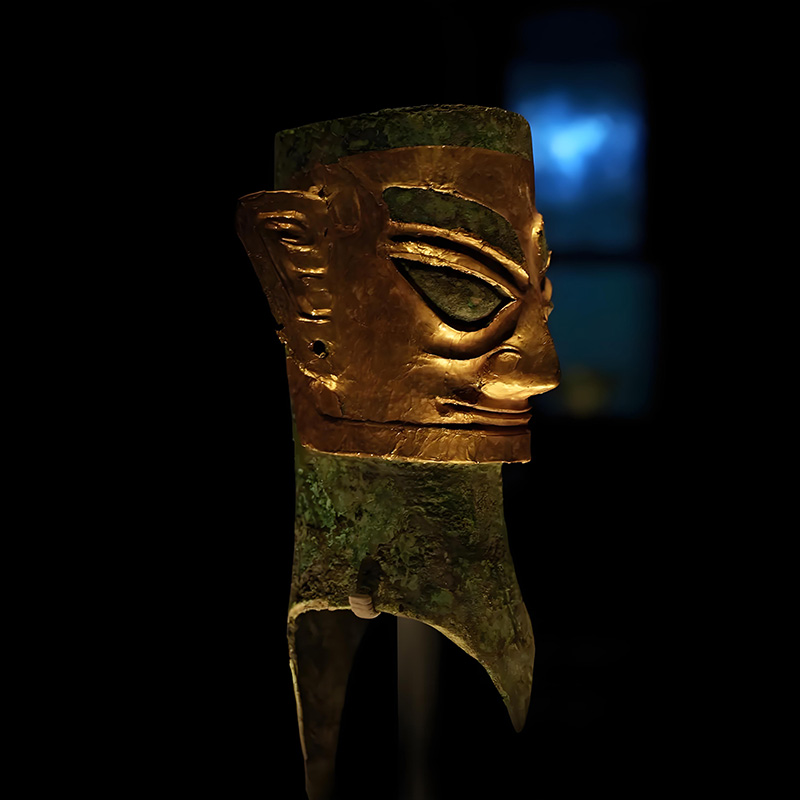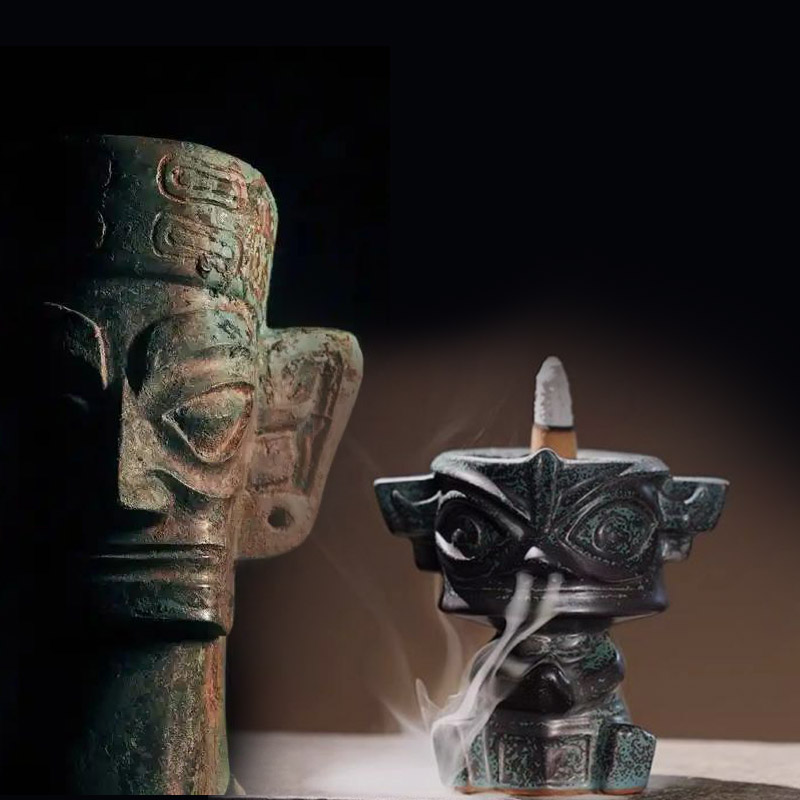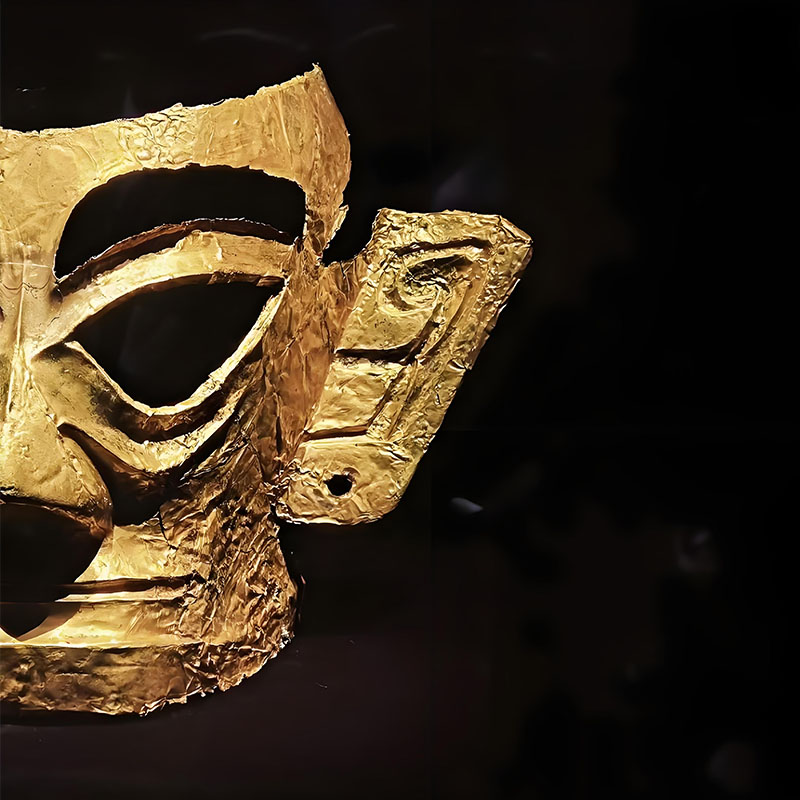Sanxingdui Backflow Incense Burner: Where Ancient Mystery Meets Modern Lifestyle
Introduction: When Ancient Civilizations Meet a Trail of Incense
On the fertile Chengdu Plain in southwest China lies one of the most mysterious archaeological discoveries of the 20th century: the Sanxingdui civilization. Buried for over three millennia, this ancient culture stunned the world with its massive bronze masks, intricate gold staffs, and ritual artifacts unlike anything found elsewhere in Chinese history. Their exaggerated facial features, wide staring eyes, and surreal artistic expressions suggest a worldview both enigmatic and transcendent—one that continues to spark fascination and speculation among historians, artists, and everyday admirers of ancient culture.
Sanxingdui is not only an archaeological site; it has become a cultural icon. It represents diversity in ancient Chinese civilization and embodies humanity’s eternal quest to connect with the divine and the unknown. Standing before the colossal bronze masks in a museum today, one cannot help but feel transported, as if peering into a forgotten cosmic ritual.
Now, imagine a very different scene in the present day. In a modern living room or meditation corner, you light a backflow incense cone. Slowly, smoke begins to drift downward, cascading like a soft waterfall. It pools gently at the base of a ceramic incense burner, creating an illusion of clouds flowing through a miniature landscape. The effect is both calming and otherworldly—almost as if the boundary between reality and myth has blurred.
What connects these two worlds—an ancient, mysterious civilization and a contemporary lifestyle ritual? The answer lies in the artistry of material culture. Just as Sanxingdui bronze masks reflect the imagination and spirituality of their creators, a backflow incense burner embodies an aesthetic that blends ritual, atmosphere, and sensory experience. And when combined with the mesmerizing beauty of yaobian glaze—known in English as “kiln-transmutation glaze”—the result is a work of art that bridges past and present, East and West, mystery and daily life.
Kiln-transmutation glaze, developed in ancient Chinese ceramic traditions, is renowned for its unpredictability. No two pieces are ever alike. The play of fire, minerals, and temperature inside the kiln produces spontaneous colors—shades of deep blue, purples, and even shimmering metallic tones that appear almost cosmic. This unpredictability mirrors the awe one feels when looking at Sanxingdui artifacts: each is a singular, irreplaceable marvel, defying repetition.
When artisans today craft incense burners that integrate Sanxingdui motifs with kiln-transmutation glazing, they are not simply creating functional objects. They are creating cultural dialogues. These burners are at once decorative art pieces, meditative tools, and vessels of history. Lighting incense becomes more than a sensory indulgence; it becomes a ritual, a way to invite ancient mystery into everyday life.
In this article, we will take a journey that explores three interconnected themes:
-
The artistic legacy of Sanxingdui—why its aesthetics continue to fascinate the modern imagination.
-
The cultural and sensory significance of backflow incense burners—how the downward flow of smoke creates unique atmospheres and experiences.
-
The craftsmanship of kiln-transmutation glaze—a celebration of unpredictability, natural beauty, and timeless artistry.
Together, these elements converge in one extraordinary creation: the Sanxingdui-inspired backflow incense burner with kiln-transmutation glaze. It is more than an object; it is a symbol of continuity between ancient heritage and contemporary lifestyle, reminding us that beauty, mystery, and spirituality transcend time.
The Artistic Legacy of Sanxingdui
To understand the fascination behind Sanxingdui-inspired incense burners, one must first grasp the extraordinary artistry of the Sanxingdui civilization itself. Unearthed in the late 20th century near Guanghan, Sichuan, Sanxingdui has been hailed as one of the greatest archaeological discoveries of the century. What shocked experts was not only the scale of the artifacts but also their sheer uniqueness. These were not simply variations of traditional Chinese bronzes; they were something altogether different, as if crafted by a civilization with its own distinct vision of the cosmos.
A Civilization Wrapped in Mystery
Unlike dynasties recorded in Chinese historical texts, Sanxingdui left behind no written language that we can currently decipher. This absence of script makes the artifacts themselves the primary storytellers. Every bronze mask, every ritual vessel, every jade ornament serves as a clue, inviting us to reconstruct a worldview that remains partly beyond our grasp.
Archaeologists believe Sanxingdui flourished between 1200 and 1000 BCE, overlapping with the Shang Dynasty in central China. Yet the artifacts unearthed at Sanxingdui look nothing like Shang bronzes. The Shang focused on ritual vessels with solemn symmetry and intricate animal motifs. By contrast, Sanxingdui bronzes emphasize surreal, larger-than-life human features—protruding eyes, enormous ears, and expressive mouths. It’s as if the artisans wanted to push human form into the realm of the divine, blending realism with cosmic exaggeration.
The Iconic Bronze Masks
The most iconic artifacts are undoubtedly the bronze masks. Some are massive in scale, with exaggerated almond-shaped eyes that project outward, almost like telescopes. Scholars interpret these features as symbolic—perhaps representing a shamanic ability to see into other realms, or to communicate with gods and spirits. The elongated ears may reflect heightened hearing, suggesting supernatural perception. These masks were not decorative; they were ritual objects, likely used in ceremonies meant to bridge the human and spiritual worlds.
Standing in front of one of these masks today, the impression is visceral. The bold geometry and stark expression feel oddly modern, even abstract, despite being over 3,000 years old. Artists from across the world have remarked how Sanxingdui’s aesthetic echoes elements of modernist sculpture and surrealism. This timeless quality explains why the culture resonates so strongly with contemporary designers and creators—it feels ancient and futuristic at the same time.
Artistic Traits That Define Sanxingdui
When we analyze the artistic DNA of Sanxingdui, several traits stand out:
-
Exaggeration and Surrealism – Features are stretched, enlarged, or transformed to emphasize supernatural power. This departure from realism gives the art a dreamlike, almost mythological aura.
-
Cosmic Symbolism – Many objects appear designed to mediate between the human and divine. Whether through wide eyes or celestial motifs, they carry a sense of connection to forces beyond ordinary experience.
-
Technical Mastery – The sheer size of the bronzes, some weighing hundreds of pounds, speaks to sophisticated casting techniques. The artisans of Sanxingdui were not primitive experimenters; they were masters pushing metallurgy to its limits.
-
A Sense of Otherworldliness – Unlike the Confucian order and harmony later emphasized in Chinese art, Sanxingdui’s aesthetic feels wild, unrestrained, and enigmatic. It embodies mystery rather than clarity.
Why Sanxingdui Inspires Modern Creators
For contemporary designers, Sanxingdui is a goldmine of inspiration. The masks, with their bold forms, lend themselves easily to modern reinterpretations—whether in fashion, sculpture, or, as we will later explore, incense burners. The surreal quality of the bronzes pairs beautifully with the ethereal effect of incense smoke. Both embody the idea of crossing thresholds: one between reality and myth, the other between the material and the immaterial.
In North America, where multicultural design is celebrated, Sanxingdui represents a bridge between global ancient heritage and modern creativity. It appeals not only to those interested in Chinese history but also to art enthusiasts who appreciate bold aesthetics. The civilization’s aura of mystery allows each person to project their own meaning onto the artifacts—whether seeing them as cosmic guardians, visionary ancestors, or even extraterrestrial messengers.
From Ancient Rituals to Modern Lifestyle
When we think about incense burners inspired by Sanxingdui, it’s worth remembering that these artifacts were originally part of ritual practice. They were not made for casual decoration; they carried spiritual weight. In a sense, using a Sanxingdui-themed incense burner today recreates that ancient intention—though in a gentler, more personal way. Instead of massive communal rituals, the modern equivalent might be a quiet moment of reflection in one’s home, where flowing incense smoke becomes a private ritual of mindfulness.
Thus, the artistic legacy of Sanxingdui is not confined to museums or history books. It lives on, continually reinterpreted in new forms. And perhaps that is the greatest tribute we can pay to this ancient civilization: to keep its spirit alive by weaving its symbols into our own cultural practices.

The Allure of Backflow Incense Burners
If Sanxingdui artifacts awaken our imagination of an ancient, mystical world, then backflow incense burners bring that same sense of wonder into our everyday lives. For many in the West, incense is often associated with yoga studios, meditation retreats, or bohemian interiors. But in Asia, incense has a much deeper cultural lineage, tied to ritual, spirituality, and artistry. The backflow incense burner, with its distinctive downward-flowing smoke effect, offers something unique—it transforms the invisible into a visible performance of air, fire, and fragrance.
How Backflow Incense Works
At first glance, the effect of a backflow incense burner seems almost magical. Light a cone of incense, place it at the top of the burner, and watch as smoke flows not upward, as one would expect, but downward, curling like a waterfall. This phenomenon is not a trick but a clever use of physics.
Backflow incense cones are designed with a small hollow tunnel that allows the smoke to sink. Because the smoke is denser than the surrounding air, it naturally falls through the channel, cascading downward. When paired with a sculpted burner, the smoke can mimic natural landscapes: drifting like clouds over mountains, flowing like rivers through valleys, or pooling like mist at the base of a sacred tree.
This interplay of science and artistry is part of what makes backflow incense so appealing. It’s not just about the scent—it’s about the experience of watching a miniature world unfold before your eyes.
Aesthetics of Smoke and Silence
Unlike regular incense sticks, which release fragrance in a more uniform upward column, backflow incense adds a visual dimension. The smoke moves unpredictably, creating swirls, eddies, and soft billows that resemble mist in a Chinese landscape painting. This visual poetry resonates with the human desire for tranquility.
In a fast-paced world where screens dominate our attention, there is something deeply restorative about slowing down to watch smoke drift. The way it pools, dissolves, and reforms carries a quiet lesson: everything is impermanent, everything transforms. For this reason, many people find backflow incense ideal for meditation and mindfulness. The flowing smoke becomes a metaphor for thoughts—appearing, drifting, and finally fading away.
From Ritual to Lifestyle
Incense has always carried ritual significance. In ancient China, it was used in ceremonies to communicate with ancestors and deities. In India, incense formed part of sacred offerings to gods. In Japan, the practice of kōdō—the “Way of Incense”—elevated it into an art form, with practitioners gathering to appreciate subtle fragrance notes as one might savor fine tea or wine.
Backflow incense burners extend this tradition but translate it into a modern lifestyle context. They are not only tools for spiritual practice but also decorative objects that enhance interior ambiance. In North America and Europe, they are increasingly popular in spaces dedicated to wellness: yoga studios, meditation rooms, and spa-like interiors. Even outside of explicitly spiritual settings, they function as conversation pieces, bridging art, science, and atmosphere.
Why Sanxingdui and Backflow Incense Belong Together
When we think about Sanxingdui-inspired burners, the pairing feels almost destined. Sanxingdui’s surreal masks and cosmic motifs evoke a sense of otherworldly power, while the flowing incense smoke creates an atmosphere that is dreamlike and ethereal. Together, they amplify each other: the artifact-inspired form becomes alive with drifting smoke, and the smoke itself feels guided by an ancient hand.
Imagine a burner shaped with motifs inspired by Sanxingdui—exaggerated eyes, curling bronze patterns, or even a miniature sacred tree. As the smoke cascades, it would not only mimic natural forms but also echo the cosmic imagination of the Sanxingdui people. In this way, the incense burner becomes more than décor—it becomes a portal, a way of experiencing the spiritual energy that animated a civilization three millennia ago.
The Emotional Appeal
Part of the allure of backflow incense is its ability to touch emotions in subtle ways. The fragrance engages the senses of smell, evoking calmness or nostalgia. The movement of the smoke captivates the eyes, drawing focus away from digital distractions. The soundless performance of incense flowing creates a small sanctuary of stillness in a noisy world.
For many Western users, this blend of sensory engagement makes incense burners an accessible form of mindfulness. You don’t need to be religious or trained in meditation to benefit. Simply lighting incense and watching it flow for a few minutes can reset your mood, reduce stress, and foster a sense of presence. It is ritual without rigidity—spirituality in everyday life.
A Bridge Between Cultures
The popularity of backflow incense in North America highlights something important: cultural practices evolve, travel, and adapt. What was once part of ancient Asian ritual has become part of a global wellness trend. Yet, unlike many wellness fads, incense carries thousands of years of heritage. Its reimagining through backflow burners ensures that this heritage continues to inspire, rather than disappear.
For Western consumers, owning a Sanxingdui-inspired backflow incense burner is more than acquiring a piece of décor. It is an invitation to participate in a global cultural dialogue. It’s a way of saying: I value history, art, and ritual, and I want these to be part of my modern life.
The Craftsmanship of Kiln-Transmutation Glaze
If the flowing smoke of backflow incense captures the ephemeral beauty of air, then kiln-transmutation glaze captures the unpredictable beauty of fire. Known in Chinese as yaobian you , this ceramic technique is one of the most enchanting contributions of ancient Chinese artisans to world craftsmanship. To hold a piece of pottery glazed with kiln-transmutation is to witness the collaboration of human skill and nature’s spontaneity—no two pieces are ever the same, and each carries a story written in flame.When paired with Sanxingdui-inspired designs, kiln-transmutation glaze does more than decorate an incense burner. It transforms it into a cosmic canvas, echoing the same sense of mystery and otherworldly presence that defines Sanxingdui itself.
What Is Kiln-Transmutation Glaze?
At its core, kiln-transmutation glaze is the product of chemistry, heat, and chance. During the firing process, mineral oxides in the glaze interact with high temperatures in unpredictable ways. Oxygen levels in the kiln, subtle temperature shifts, and even the placement of the piece inside the kiln can cause dramatic differences in color and texture.The results are breathtaking. A single piece may display deep cobalt blues merging into purples, streaks of crimson bleeding into metallic sheens, or shimmering specks that look like stars scattered across the night sky. This randomness is not seen as imperfection but as the highest expression of ceramic artistry. The beauty lies precisely in its unpredictability.
A Tradition Rooted in Ancient China
Kiln-transmutation glaze first appeared during the Tang and Song dynasties, a time when Chinese ceramics reached artistic heights admired around the world. Song Dynasty potters in particular prized subtlety, exploring how glazes could mimic natural phenomena—mist over mountains, the sky before dawn, or jade-like textures.While precise techniques were often guarded secrets, the philosophy behind kiln-transmutation reflected a broader Chinese worldview: harmony between human effort and the forces of nature. The potter shapes the clay, prepares the glaze, and tends the fire—but the final outcome belongs partly to chance, to the mysterious will of the kiln.This balance between control and surrender mirrors the Taoist principle of wu wei (effortless action), where beauty arises when humans work with nature, not against it.
The Aesthetic of the Unpredictable
In Western culture, art is often associated with mastery and control—the artist dictates every detail of the final product. Kiln-transmutation challenges this notion. Here, the artisan must accept that part of the process is beyond prediction. The kiln becomes a collaborator, not just a tool.The result is ceramics that feel alive. Looking at a piece with kiln-transmutation glaze, one often sees landscapes, galaxies, or flowing rivers, even though none were intentionally painted. The surface seems to shift under different lighting, offering new impressions each time. It is art that resists finality—forever inviting the viewer to discover more.
Why It Resonates with Modern Design
For today’s collectors and lifestyle enthusiasts, kiln-transmutation glaze holds a special allure. In an age of mass production and uniformity, the uniqueness of each piece feels luxurious. No one else will ever own an identical item. The glaze embodies authenticity and individuality—values cherished in contemporary design culture.This makes kiln-transmutation especially appealing in North America, where consumers are drawn to artisanal products with a story. Owning a burner with kiln-transmutation glaze is not just about function; it is about having a one-of-a-kind artwork that connects to centuries of craftsmanship.
When Kiln-Transmutation Meets Sanxingdui
Now imagine combining this ancient ceramic technique with the surreal motifs of Sanxingdui. A burner shaped like a stylized mask, its bold features shimmering under a glaze that shifts from deep bronze to cosmic purple. Or a sacred tree design, its branches glazed in flowing blues that resemble celestial skies.The randomness of the glaze amplifies Sanxingdui’s aura of mystery. Just as we cannot fully decode the meanings of Sanxingdui artifacts, we cannot fully predict the colors of kiln-transmutation. Both speak to forces larger than ourselves—ancient ritual on one hand, elemental fire on the other.Together, they create incense burners that are not just decorative but deeply symbolic. Each piece is a dialogue between history and chance, between human intention and natural transformation.
The Experience of Ownership
For the modern user, owning a Sanxingdui-inspired burner with kiln-transmutation glaze is about more than aesthetics. It is about participation in a tradition of wonder. Lighting incense on such a burner feels different. The smoke flows downward in soft curls, while the glaze shimmers and shifts in the light. The object becomes a performance, a ritual, a meditation.In this sense, the burner embodies three layers of meaning:
- The heritage of Sanxingdui – carrying forward a civilization’s artistic imagination.
- The magic of backflow incense – turning fragrance into visual poetry.
- The beauty of kiln-transmutation glaze – capturing fire’s unpredictability as permanent art.
Each time incense is lit, these layers converge into a single, living experience.
A Bridge Between Past and Present
Ultimately, kiln-transmutation glaze reminds us that beauty often arises from uncertainty. Just as Sanxingdui artifacts continue to puzzle and inspire us, kiln-transmutation glazes continue to surprise even the artisans who create them. Both invite us to embrace mystery, to find joy in what cannot be fully explained.For Western audiences, this is especially resonant in today’s world. Amid a culture obsessed with precision, data, and control, kiln-transmutation whispers a different message: that sometimes, letting go produces the most profound beauty. And when this philosophy is embodied in an incense burner, it turns a simple act—lighting incense—into a celebration of unpredictability, heritage, and timeless art.
Culture and Lifestyle Fusion
When ancient symbols, sensory rituals, and artisanal craftsmanship converge, the result is more than an object—it is a lifestyle expression. The Sanxingdui-inspired backflow incense burner with kiln-transmutation glaze is not simply a piece of décor. It embodies a cultural conversation, one that stretches across time and geography, weaving the mystery of a Bronze Age civilization into the rhythm of modern living.
From Ancient Rituals to Modern Mindfulness
In Sanxingdui, ritual artifacts were used to bridge the human and the divine. They were meant to channel energy, honor ancestors, and connect with forces beyond the visible world. Today, while our daily lives are far removed from Bronze Age ceremonies, the desire for ritual remains.
Lighting incense in a Sanxingdui-inspired burner is not a grand religious act but a quiet, personal one. It may mark the start of a meditation session, the winding down of a busy workday, or the simple pleasure of enjoying tea in silence. The act carries the same essence: creating a threshold between ordinary time and sacred time. In this way, the ancient impulse to sanctify space finds new life in modern wellness practices.
Design That Resonates Across Cultures
For Western consumers, part of the appeal lies in design that feels both exotic and universal. The bold features of Sanxingdui masks echo the language of contemporary sculpture; the unpredictability of kiln-transmutation glaze mirrors the aesthetics of abstract painting. These burners do not feel like distant museum relics but like living works of art that belong in a modern home.
Placed on a coffee table, meditation altar, or office desk, they serve as conversation starters. Guests may ask about the surreal mask design or the shimmering glaze, and the owner can share not only the beauty of the piece but also the story of an ancient civilization. In this way, each burner functions as both décor and storytelling vessel.
Spaces Transformed by Smoke and Light
The sensory experience of using such a burner goes beyond fragrance. The drifting smoke creates a moving sculpture that interacts with light, shadow, and texture. In a minimalist interior, it adds depth and softness. In a bohemian or eclectic space, it enhances the layered aesthetic of art, travel, and culture.
Wellness spaces, in particular, benefit from this effect. Yoga studios, spas, or home meditation corners are enriched by the calming atmosphere that incense creates. The flowing smoke becomes a visual mantra, steadying the mind as the fragrance soothes the body.
Why It Matters Today
In a world of fast production and digital overload, there is a growing hunger for authenticity. People want objects with meaning—pieces that carry stories, history, and artistry. A Sanxingdui-inspired incense burner meets this need by offering more than function. It offers a connection: to ancient mystery, to the unpredictability of fire and glaze, and to the simple act of pausing to breathe.
Owning such a piece is not about nostalgia. It is about integration—finding ways to let the past enrich the present. It is about surrounding ourselves with beauty that is layered, symbolic, and alive.
Lifestyle, Elevated by Heritage
Ultimately, culture becomes most powerful when it shapes how we live. The Sanxingdui backflow incense burner with kiln-transmutation glaze is not only a collectible or a craft object. It is a lifestyle artifact, elevating daily moments into rituals of presence and connection. Whether used in meditation, tea ceremonies, or simply as art within a home, it reflects the timeless human desire to bring meaning into the everyday.
Through such objects, heritage is not confined to museums. It becomes part of our personal narrative—something we live with, use, and cherish.

Conclusion: A Dialogue Across Time
The Sanxingdui-inspired backflow incense burner with kiln-transmutation glaze is more than a crafted object—it is a bridge. On one side lies the mystery of an ancient Bronze Age civilization, with its surreal masks and cosmic symbols that still defy complete understanding. On the other side lies the modern world, where wellness, mindfulness, and lifestyle design seek to restore balance in our daily routines.
In bringing these two worlds together, the incense burner becomes a vessel of dialogue. The drifting smoke recalls ancient rituals yet feels perfectly at home in contemporary interiors. The glaze, shaped by fire and chance, mirrors the unpredictability of life itself. And the Sanxingdui motifs remind us that human imagination has always reached toward the unknown.
For Western audiences, owning such a piece is not simply about collecting décor. It is about participation in a cultural story—one that celebrates mystery, artistry, and timeless human creativity. It turns the simple act of lighting incense into an experience that honors both the past and the present.
In the end, perhaps this is what makes the Sanxingdui backflow incense burner so compelling: it is at once ancient and modern, ritualistic and aesthetic, mysterious yet deeply human. It reminds us that beauty is not bound by time, and that even a small trail of smoke can carry the weight of history into the quiet corners of our lives.
 English
English









